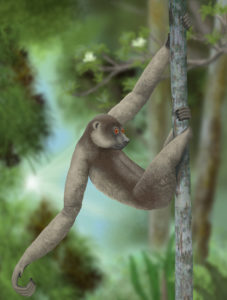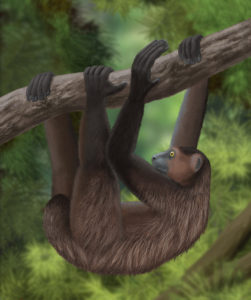Just 500 or 1000 years ago – in the history of the earth, that’s just the blink of an eye – countless giant animals lived on Madagascar. Among them were the famous elephant birds, a giant tortoise, and a creature you would never expect to find in Africa: a giant sloth. Sloths, as we know them today, are only found in South America. In fact, the Madagascan giant sloth was more closely related to the lemurs than to today’s sloths. Only externally a striking similarity can be found.

There have even been four different species of the Malagasy giant sloth lemurs. The largest, Archaeoindris fontoynonti, weighed 160 to 200 kg. It lived in contrast to the smaller species probably mainly on the ground. Actually quite logical: The branches of a tree could carry such a giant hardly durably. The other three known giant sloth lemurs moved like today’s sloths hanging upside down on branches – and were probably just as slow. Babakotia radofilai weighed about 15 kg, slightly more than today’s indris. By the way, the name of this giant sloth also goes back to the indri: Babakoto is the pet name of Madagascar’s largest lemur. Mesopropithecus globiceps, pithecoides and dolichobrachion weighed an estimated 10 kg and also moved upside-down through the branches. The last two giant sloths, Palaeopropithecus ingens and maximus, probably weighed 40 to 60 kg. Hands and feet were hooked to facilitate hanging from branches. Just as the claws of today’s sloths are curved.

The Malagasy giant sloth lemur fed mainly on foliage. The teeth of skulls found today at least clearly indicate this. From the close relationship to the Indri, it can be concluded that the giant sloth lemur also required a very special diet consisting of a variety of different leaves, buds, and flowers. It probably occupied small, ecological niches and was correspondingly susceptible to disturbances of its habitat.
Why the Malagasy giant sloth lemur became extinct has not been conclusively clarified to this day. It is believed that the settlement of Madagascar by humans about 1500 years ago was a turning point for the giant sloth lemurs. With their ponderous, slow locomotion and much muscle mass, i.e. meat, they might have been a worthwhile hunting prey. Perhaps extended dry periods and the slow disappearance of forests also led to the end of the giant sloth lemurs. That humans and giant sloth lemurs lived side by side for quite a while is now considered proven. Malagasy legends tell of a giant creature with a short tail hanging upside down from a tree. It is called Tretretre and is rumored to have been last seen alive around 1600. But who knows, maybe it still survives today somewhere in a remote forest, far from humans? Madagascar still guards so many treasures – it would not be surprising if a giant sloth was among them.
 MADAMAGAZINE Your Magazine about Madagascar
MADAMAGAZINE Your Magazine about Madagascar





